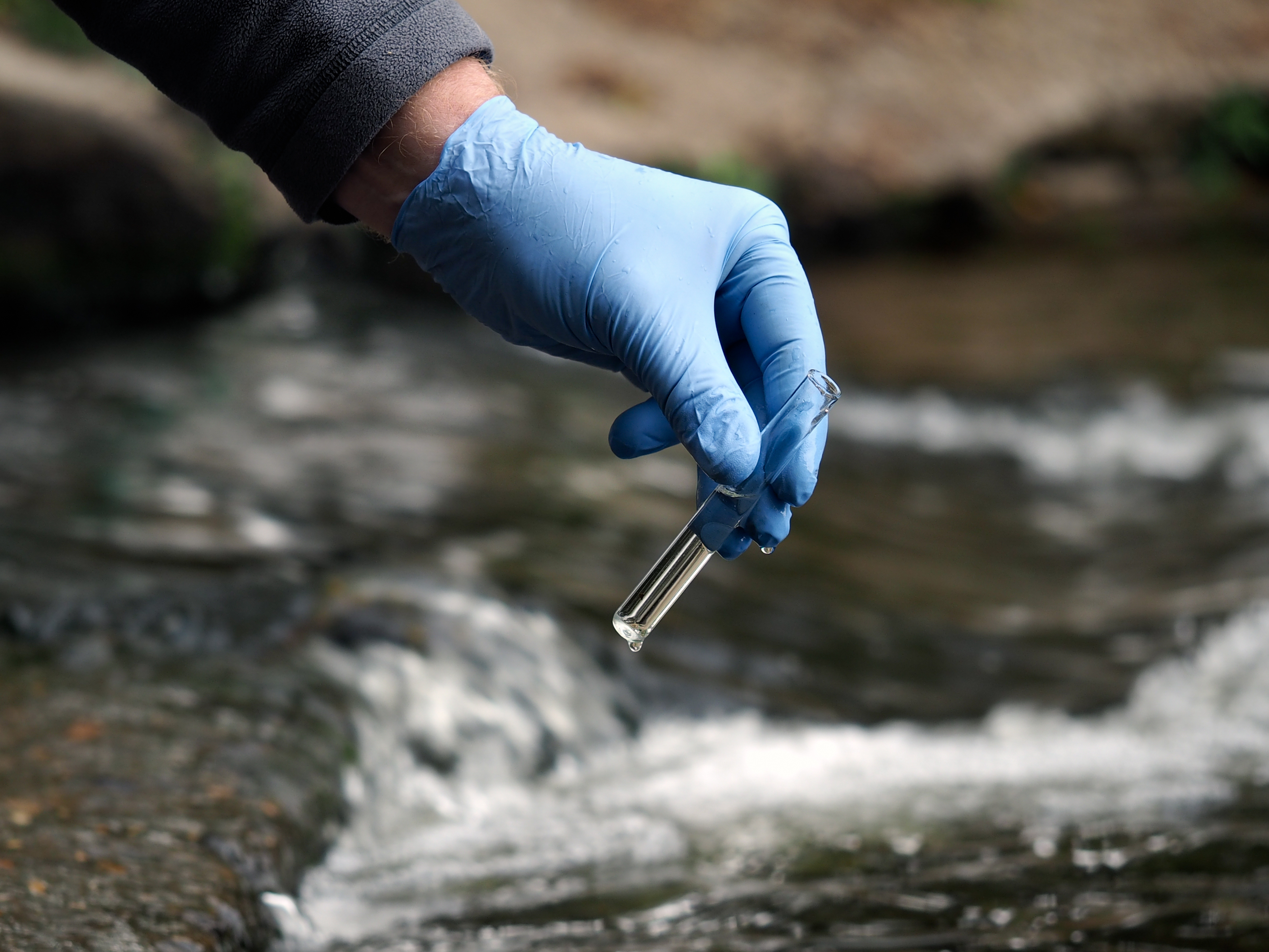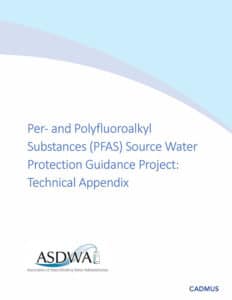

PFAS are a class of thousands of different chemicals that have been manufactured and used in a variety of commercial products since the 1940s – from everyday household items to food packaging – due to its heat, moisture, and stain resistance and non-stick qualities. PFOA and PFOS have been the most extensively produced and studied of these chemicals, followed by PFHxS and PFNA. These chemicals do not break down in the environment or human body, and can accumulate over time. There is evidence that PFAS exposure can lead to adverse health effects.
ASDWA PFAS MCLs White Paper – November 2021: This White Paper entitled, “Lessons Learned from States and Challenges Ahead in Setting State-Level Per- and Polyfluoroalkyl Substances (PFAS) Standards,” provides an overview of current state PFAS efforts and seven topic sections on the key components of the regulatory setting process for states that are developing or considering developing PFAS drinking water Maximum Contaminant Level (MCL) regulatory standards or guidelines, or want to take other actions to assess and address PFAS. View the November 29, 2021 webinar recording and slides here.
ASDWA Joint Letter of Comment with ACWA, ECOS, and ASTSWMO on EPA’s ANPRM for PFAS Effluent Limitations Guidelines – May 17, 2021: Our joint comments highlight the need to prevent PFAS pollution and difficulty in generating PFAS data due to the lack of analytical methods for monitoring surface waters.
ASDWA Letter of Comment on EPA Interim PFAS Destruction and Disposal Guidance – February 22, 2021: This letter highlights concerns for state drinking water programs and water utilities and provides recommendations for EPA to undertake a holistic lifecycle approach to assess and address PFAS destruction and disposal impacts for drinking water and to protect public health.
ASDWA PFAS – Source Water Protection Guide and Toolkit ASDWA developed this guide and toolkit with support from a Project Advisory Council (PAC) with representatives from nine states (Colorado, Kansas, Minnesota, New Hampshire, North Carolina, Pennsylvania, Vermont, Virginia, and Wisconsin), and the Cadmus Group. The purpose of the guide is to demonstrate and share effective strategies for addressing PFAS contamination risk in source waters that will help inform policy decisions, assist state drinking water programs in protecting public health, and encourage collaboration and communication among states and water utilities.
The ASDWA PFAS SWP – Decision Support Tool is downloadable in Excel and provides examples of state actions to address PFAS contamination. It includes an update form for states and other organizations to submit updates or new entries for the Tool. The factsheet for Communicating with Industry on PFAS Contamination includes best practices and questions with fillable fields to support state planning efforts. The Technical Appendix includes an overview of PFAS, chemicals of concern, PFAS in the U.S., and state PFAS profiles. The Mapping Guide aids identifying and mapping source waters that are vulnerable to PFAS contamination.The tool includes three main components and a factsheet:
PFAS Background: The understanding of potential drinking water impacts from PFAS has significantly increased over the past decade. This class of chemicals started to get publicity in 2001 & 2002 due to water contamination from the Washington Works Plant located outside of Parkersburg, West Virginia, on the West Virginia/Ohio border. The class-action lawsuit against DuPont due to water contamination at Little Hocking Water District and Lubeck Public Service District generated additional publicity. In 2006, DuPont and other manufacturers such as 3M, agreed to principally phase out the production of PFOA and PFOS.
(NEW!) EPA’s Proposed National Primary Drinking Water Regulation (NPDWR) for Six PFAS
On March 14, 2023, EPA released the proposed National Primary Drinking Water Regulation (NPDWR) for PFOA and PFOS, along with four additional PFAS. EPA is proposing to set a Maximum Contaminant Level (MCL) of 4 parts per trillion (ppt) for PFOA and 4 ppt for PFOS, levels at which they can be reliably measured. In addition to these two MCLs, EPA is proposing to address four additional PFAS (GenX, PFBS, PFNA, and PFHxS) as a mixture using a Hazard Index. The Hazard Index is a tool used to evaluate potential health risks from exposure to chemical mixtures. This approach has been used in other EPA programs, such as the Comprehensive Environmental Response, Compensation, and Liability Act (CERCLA), but this is the first time it has been used for a drinking water standard. Additionally, EPA is proposing Maximum Contaminant Level Goals (MCLGs) for each of the six PFAS. The MCLs and MCLGs are as follows.
Proposed NPDWR
| Compound Name | Proposed MCLG | Proposed MCL | |
| PFOA | Perfluorooctanoic acid | 0 ppt | 4 ppt |
| PFOS | Perfluorooctanesulfonic acid | 0 ppt | 4 ppt |
| GenX | Hexafluoropropylene oxide dimer acid | HI = 1.0 | HI = 1.0 |
| PFBS | Perfluorobutane sulfonic acid | HI = 1.0 | HI = 1.0 |
| PFHxS | Perfluorohexanesulfonic acid | HI = 1.0 | HI = 1.0 |
| PFNA | Perfluorononanoic acid | HI = 1.0 | HI = 1.0 |
*Hazard Index (HI) is unitless
For the Hazard Index, the rule proposes a ratio for each of the four PFAS to be used to calculate a compliance value based on detected levels of the four PFAS. If the combination of those four ratios is at or above 1.0, then water systems will be expected to reduce the levels of these PFAS. Depending on the level of contamination found, water systems may need to take action even if only one of the four PFAS is present. EPA will be creating a webpage with a calculator tool for water systems to determine their Hazard Index. Once the proposal is published in the Federal Register, the public will be given 60 days to provide comments.
EPA’s 2022 Health Advisories: On June 15, 2022, EPA released the long-anticipated updated interim health advisories for PFOA and PFOS, as well as the final health advisories for GenX and PFBS. Under the 2022 HA levels, PFOA and PFOS are no longer combined. PFOA’s HA level is now 0.004 ppt, and PFOS’s HA level stands at 0.02 ppt. GenX and PFBS have HAs for the first time at 10 and 2000 ppt, respectively.
EPA PFAS Health Advisories
| Compound Name | 2009 EPA HAs | 2016 Revised HAs | 2022 EPA HAs | |
| PFOA | Perfluorooctanoic acid | 400 ppt | 70 ppt (individual and combined sum with PFOS) | .004 ppt* |
| PFOS | Perfluorooctanesulfonic acid | 200 ppt | 70 ppt (individual and combined sum with PFOA) | .02 ppt* |
| GenX | Hexafluoropropylene oxide dimer acid | NA | NA | 10 ppt |
| PFBS | Perfluorobutane sulfonic acid | NA | NA | 2000 ppt |
*EPA interim health advisory levels.
What is a drinking water health advisory?
Health advisories are not legally enforceable and reflect EPA’s assessment of the health risks of a contaminant. Unlike the legally enforceable maximum contaminant levels (MCL) under the Safe Drinking Water Act (SDWA), health advisories are based solely on EPA’s assessment of the risks and are not based on any consideration of the feasibility, costs, or benefits of reducing contaminant levels.
Provisional vs. Interim vs. Final Health Advisory
From EPA: EPA can develop interim or provisional HA levels to provide information in response to an urgent or rapidly developing situation. Interim or provisional HAs are also based on health-based hazard concentrations above which action should be taken to reduce exposure to unregulated contaminants in drinking water. In contrast, final health advisories are based on final health effects assessments.
In the case of PFOA and PFOS: These interim health advisories are intended to be in place during the time interval between initial understanding of health effects and publication of the final health advisory or maximum contaminant level goal (MCLG) and National Primary Drinking Water Regulation. EPA anticipates proposing a National Primary Drinking Water Regulation by the end of 2022 and finalizing it by the end of 2023.
HAs Versus Regulatory Standards Create Challenges: Use of HAs as guidance, versus a Safe Drinking Water Act (SDWA) regulation with an established Maximum Contaminant Level (MCL) creates challenges for state drinking water programs and public water systems. The HAs for PFOA and PFOS do not provide clarity on necessary actions for water systems to address the compounds, and how to communicate their actions and the associated health risks to the public.
State Regulatory and Oversight Challenges: States are having to make tough decisions about whether or how to implement HAs and address PFAS in drinking water in the absence of federal standards. The table below shows the states that have proposed or established PFAS standards or guidelines that are lower or different than EPA’s HAs. These numbers demonstrate the variation in health risk goals and risk reductions among states in the absence of federal standards and are creating public confusion about what levels of PFAS are safe in drinking water.
2019 EPA PFAS Action Plan: Commitments by EPA in the action plan included:
Third Unregulated Contaminant Monitoring Rule (UCMR3): Due to escalating concerns, six PFAS compounds were included in EPA’s final UCMR3. UCMR3 monitoring occurred between January 2013 and December 2015 and included two to four quarterly samples at mostly large water systems throughout the country using EPA Method 537. As typical for the UCMRs, EPA regularly released the UCMR3 monitoring data, starting in late 2013.
EPA’s 2009 Provisional and 2016 Revised Health Advisories (HAs): In 2009, EPA established provisional health advisories (HAs) for PFOA at 400 parts per trillion (ppt) and for PFOS at 200 ppt; those two numbers were the benchmark at that time, even though an EPA health effects review was underway. Based on the provisional health advisories, national occurrence in UCMR3 for PFOA and PFOS, at the time, appeared to be relatively low. In May 2016, EPA released revised HAs for the sum of PFOA and PFOS at 70 ppt. This numerical reduction significantly increased the number of water systems impacted.
State Actions to Address PFAS in Drinking Water
| State | Drinking Water Action | Compound | Level (ppt) |
| California |
PFOA PFOS PFBS PFOA PFOS PFBS |
10 40 5000 5.1 6.5 500 |
|
| Connecticut | Action Level | Sum of PFOA, PFOS, PFNA, PFHxS, PFHpA | 70 |
| Illinois | Health Advisory Levels 7/27/21 |
PFOA PFOS PFNA PFHxS PFBS PFHxA |
2 14 21 140 2100 560,000 |
| Massachusetts | Adopted Regulation 9/16/20 | Sum of PFOA, PFOS, PFNA, PFHxS, PFHpA, PFDA | 20 |
| Michigan | Adopted Regulation 8/3/20 |
PFOA PFOS PFNA PFHxS PFBS PFHxA GenX |
8 16 6 51 420 400,000 370 |
| Minnesota |
Health Based Guidance for Water Surrogate of PFOS HBV |
PFOA PFOS PFHxS |
35 15 47 |
| New Hampshire | Adopted Regulation 10/1/19 |
PFOA PFOS PFHxS PFNA |
12 15 18 11 |
| New Jersey |
PFNA PFOA PFOS |
13 14 13 |
|
| New York | Adopted Regulation 7/30/20 |
PFOA PFOS |
10 10 |
| North Carolina | Health Advisory | GenX | 140 |
| Vermont | Adopted Regulation 3/17/20 | Sum of PFOA, PFOS, PFNA, PFHxS, PFHpA | 20 |
| Washington | State Action Levels 1/1/22 |
PFOA PFOS PFNA PFHxS PFBS |
10 15 9 65 345 |
| Wisconsin | Adopted Regulation 8/1/22 | Sum of PFOA and PFOS | 70 |
Click to expand the section below to see more examples of state efforts:
More PFAS Contamination Sites are Being Found: The number of PFAS contaminated sites continues to grow. Over the past decade, PFAS contamination was found in many more locations beyond where the UCMR3 required water systems to conduct monitoring. Initially, contamination was thought to be somewhat limited to the chemical manufacturing facilities but has now expanded to include military bases, fire-fighting foam application, storage, and disposal sites, manufacturing sites of fire-retardant materials, landfills, and many other locations, including some that appear to be caused by air deposition.
| ASDWA PFAS Recommendations to EPA and CDC |
|
ASDWA’s State Drinking Water Program Recommendations to EPA and CDC on PFAS (1/12/18) includes the following recommendations:
|
The Number of PFAS Being Manufactured Continues to Grow: The number of PFAS compounds that might be a cause of concern is thought to be in the hundreds and continues to grow. Since the phase-out of PFOA and PFOS, companies have shifted to “short-chain” PFAS such as GenX, which is now a significant concern in the Cape Fear Watershed downstream of a Chemours manufacturing plant in North Carolina. The increasing number of PFAS of concern is creating a host of data collection and analysis issues, as regulators and researchers are struggling to get enough robust health effects, analytical methods, and treatment data to make smart decisions.
ASDWA PFAS Water Utility Treatment Case Study – Town of Blades, Delaware – December 14, 2018: This case study was developed for ASDWA by the Town of Blades, where high levels of PFOA and PFOS were found in their wells. The town worked with the state, EPA, and many partners to undertake subsequent actions to add GAC treatment and investigate the source of contamination. The case study includes information about their efforts; their treatment needs, considerations, and decisions; and the associated costs.
ASDWA Webinar: PFAS Treatment Options and Considerations for Drinking Water Utilities – October 2018: This webinar shared information from four companies that offer PFAS treatment technologies for drinking water utilities.
EPA Website on Drinking Water Treatment Technologies – August 2018: The site includes some general information on reducing PFAS in drinking water using activated carbon, ion exchange, and high-pressure membranes. The site also includes a link to EPA’s Drinking Water Treatability Database with more information.
New Jersey Recommendations for PFAS Drinking Water Treatment Options – June 2015: This document developed by the New Jersey Drinking Water Quality Institute Treatment Subcommittee provides drinking water treatment options for removing PFOA, PFOS, and PFNA, as well as some short case studies with treatment information and costs from a few water utilities. There are two addendums dated August 2016 and November 2017 to the original document that update information about treatment and the case studies.
Cape Fear Public Utilities Desktop Evaluation of Alternatives – GenX and Other PFAS Treatment Options Study – July and September 2017: This document includes two Technical Memorandums (TMs) developed by Black & Veatch. The first TM1 compares treatment methods – Granular Activated Carbon, Ion Exchange, and Reverse Osmosis or Nanofiltration for the water utility, and the second TM2 presents planning level opinions of probable cost for treatment options previously selected in TM1.
EPA Resources:
CDC:
Department of Defense (DoD) Resources:
Industry Resources:
Water Research Foundation (WRF) Resources:
Risk Communication Resources
For more information on how states are addressing PFAS, contact Stephanie Schlea at sschlea@asdwa.org or Deirdre White at dwhite@asdwa.org
Download a PDF-version of this webpage.
ASDWA’s PFAS News Feed
ASDWA publishes content covering various areas of the drinking water program.

2021 © All Rights Reserved. Privacy Policy.
